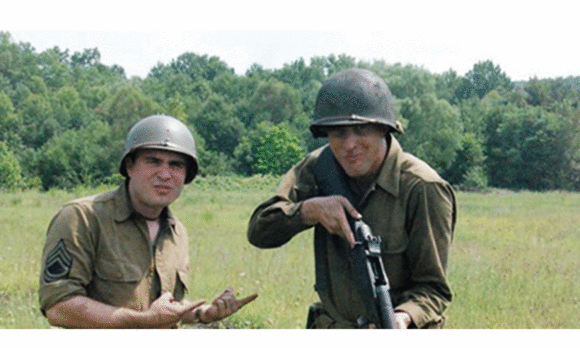
Karate must keep the high ground and here is proof from nature, history, battle, sports, and bars. Nature kills a horse from the ground up. What that means is the ground is bad and for us as martial artists. The ground is a bad place for a warrior. I addressed this in my 1st book, Lessons from the Dojo, close to twenty years ago.
I want to take a moment and add more color to this. Years ago, I was on a farm, the guy who owned the farm had several horses. The owner had a farrier come out of those new shoes on the horses. The farrier began to do his business clipping, cleaning, and fattening the horse’s hoofs.
Karate High Ground and Horses
Watching the farrier do his job is interesting. But then again, I find it entertaining to watch anybody who is a master of their craft.

While watching the farrier with the horses I started asking questions of him. One of the more obvious questions was, “Why do we need to do this I don’t see anybody putting shoes on horses in the wild?” He answered that the ground was different from where the horses once lived. The ground was not as soft as a stall, or a track, and the horses’ hoofs grew rapidly and that’s why he has to come in and cut. This of course is designed to make it easier for the horse to get around.
The farrier hadn’t become annoyed by my questions. He did have an interesting answer when he was shaping the horse’s shoe. “Putting on and fitting them (the horseshoes) is everything.” I acknowledged, “You are being precise about that.” He concurred, “I have to be because nature kills a horse from the ground up.”

Breaking Bones and Bugs
That required some thought. Instead, what I did was I asked him more questions. Standing up and turning to me adding clarity. “The ground can break a leg. The ground can do a lot of things, there are pathogens in the ground, there are infections that happen,” as he was explaining all these bad things that could happen when a horse comes in contact with the ground. These all kill a horse from the ground up. He noted, the other thing was a horse was dead, “If the horse can’t run, it becomes prey to the mountain lion.”

The simplicity and profundity of his story were clear. The farrier is pointing out, for us, the ground is a bad place to be for all the reasons that a horse wants to avoid the ground. This is the beginning of knowing karate must keep the high ground,
Agincourt
In 1415 the battle between the English and the French took place at Agincourt. The French arrived armored. The metal used by the French in their armor was exceptional.
The French metal was resistant to the English arrows. The English bows couldn’t generate enough force to drive an arrow enough to pierce the French metal. Confident the French showed up with a 3:1 ratio over the English in the number of men. Those numbers and the armament say The Battle of Agincourt should be a rout by the French over the English.
It didn’t turn out that way.
The ground became an instrumental aspect in the French loss. The ground at Agincourt had become wet and had turned into a kind of clay a muddy sticky adhesive clay. When the French would walk in the water-bound clay the clay would adhere to the soles of their feet. If you’ve ever experienced this you have had to stop and scrape the clay from your feet.

Without removing the clay, it continues to build-up. Scraping the clay off the soles of their armor is time-consuming and any residual clay attracts more clay. The French became heavily bound in the mud.
The ground was pining the best of the French forces down and the English were able to seize the day with hammers and picks. The English using picks and hammers to strike through the armament of the French and kill them. Yes, hammers made the difference, but in essence, the ground ruining the French ability to fight offensively resulted in their loss.
Castles, Bombers, and Karate
The high ground is always sought in a battle. The castle is built on high ground, not in valleys. Air superiority since World War II has had a component of any battlefield or battlefront.

Once you own the high ground your power is in a superior position of the high ground. The low ground being a poor position. One of the things that Sun Tzu says in his book, The Art of War, is one should never fight uphill. That’s clear at least in the context of the warrior, or the karate-ka, karate must keep the high ground.
Going to the ground is a bad thing in combative applications
In a sports competition, it’s a fantastic idea. Let me tease some of that out. In the sporting arena, the goal is to be able to survive so you can compete again. In most sporting competitions, not every sport, but going to the ground is either submission or end of the play. Two examples being boxing or, as in a football player being downed.
Going to the ground in a sport is often a method of avoiding an injury. A broken wrist, hyperextended elbow, or a concussion as examples. Hitting the ground poorly ruins the chances for continued practice and competition.
The listed injuries are the things you’re trying to achieve in a combative situation. You want the ground to hit the other person hard. If you dislocate or break something all the better.

Judo and wrestling underscore the importance of falling correctly. Keeping your feet, and the dominant high ground position. In our world, today, losing your feet in a riot, or a mob is deadly. In this situation, the ground is a bad place to be as the mob has no mercy. Mobs never have had mercy and never will, they are incapable of mercy.
Swords and The History of the High Ground
The Japanese Tachi, a sword, and as I understand it, a precursor to the Katana. The Tachi was longer than the katana. The longer blade of the Tachi allows the horseman to hack down at the foot soldier.
This sword style is not exclusive to Japanese culture. You can find this kind of sword usage in other parts of Asia, the Middle East, and Europe. Long swords swinging down from horseback is omnipresent because it works. All are a demonstration of the desire for the high ground.
Children and The High Ground
Thinking about a child learning to walk. We learn to walk as children because it’s better. It’s better to stand. It’s better to have some height so you can survey the surroundings. It is better to acquire a potential threat at a distance.
The higher I am the farther I can see. Now the advantage of standing is clear. The advantage of high ground to be able to see. That’s why reconnaissance airplanes exist, as alluded to before. That’s why we have unmanned drones, and spy satellites.
History and nature prove that being on the ground is bad. Learning to control your falls is important for sports and for last-ditch efforts to survive a throw.

As further proof ask a bouncer and they will tell you the guy who goes down to the ground in the bar is the one who’s in jeopardy. No bouncer wants to go to the ground at any time, it’s nasty down there in many ways.
A Farrier, a battle in 1415, where to build castles, an ancient manuscript, sports, swords, and the nature of standing upright.
What more proof do you need to avoid the ground and keep your feet underneath you. Karate must keep the high ground. You can get more information and tactical recommendations in our book. Their are several levels of action listed in the book, Dirty Ground, but the bottom line is: Karate must keep the high ground
Here are some other links on martial arts you may find interesting
Let’s Connect
KRIS WILDER
Kris Wilder is a martial artist based in Seattle Washington. He has authored many martial art books, including the classic, The Way of Kata. Making no apologies for his obsession of Football he can be found telling any who will listen about the nuances of the Canadian Football League.












